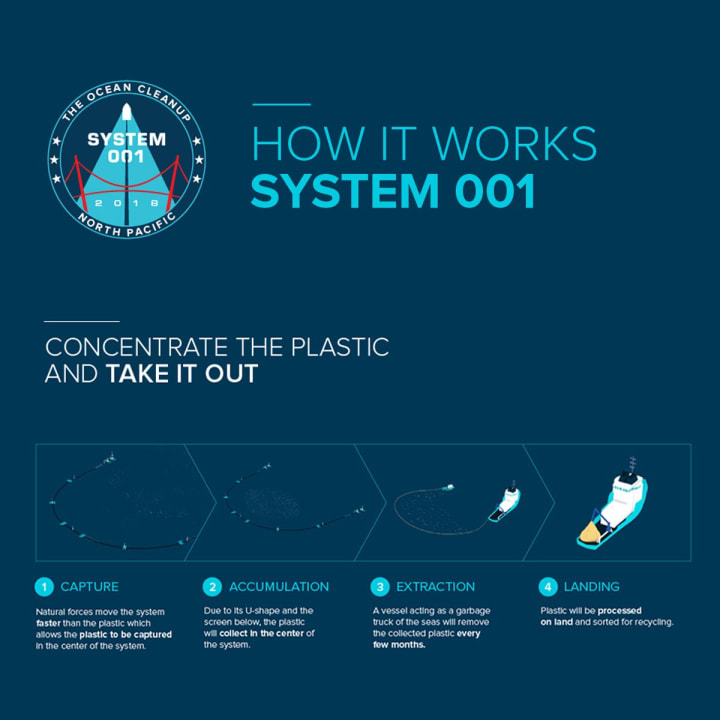Cleaning up the Ocean
Techniques on how to remove plastics from the Ocean.

Many people might not know, but plastic has been important for human evolution, and we use it for multiple things. The problem with plastic is that it doesn’t just disappear; it sticks around for hundreds of years and sometimes it ends up in the natural environment, mostly on the ocean. Plastics can get to the ocean in different ways; for example, the rain and winds can drag plastics to the ocean, but that’s not the only way they can get to the ocean, another common way is through storm drains. When plastics reach the ocean, they never break down completely, instead they turn into really small pieces called microplastics that can be dangerous for marine life. A study run by the Monterey Bay Aquarium shows that small ocean animals are consuming microplastic particles; yes, those are the same ocean creatures that we consume. These microplastic particles mainly come from consumer products like plastic water bottles and product packaging, but not all plastics in the ocean get to break down into microplastics, sometimes plastics end up being eaten by large ocean animals, which is really dangerous for them because their digestive system can get clogged up. Once their digestive system is clogged up, the animal stops receiving the nutrition that they need and end up dying with their stomachs full of plastic (“Plastic pollution”). I believe we should become more aware of the problems that plastics are bringing to the ocean and worry about finding a way to take plastics out of the ocean and planning on what to do with those plastics after they out of the ocean.
Many people wonder what plastic is made of or where it comes from, well plastic is made from materials found in nature, such as natural gas, oil, coal, minerals, and plants. The first man to ever discover how to create synthetic plastic was John Wesley Hyatt, who was inspired when a New York firm offered $10,000 to anyone that could come up with a substitute for ivory; he then invented synthetic polymer in 1869. Hyatt discovered that by treating cellulose he could create a plastic that could be crafted into different shapes, making it a perfect substitute for ivory, horns, and even tortoiseshells (“The history and future”). For the first time in human history, men were not contained by the limits of nature; they had discovered a way to create new materials. Plastic was revolutionary. At that time, it was believed that “Plastic could protect the natural world from the destructive forces of human need” (“The first synthetic”). Thirty years later humans needed a plastic able to insulate electricity. “Baekeland had been searching for a synthetic substitute for shellac, a natural electrical insulator, to meet the needs of the rapidly electrifying United States” (The development”). Leo Baekeland invented the first fully synthetic plastic in 1907, which he called Bakelite. Not only does Bakelite work as a good insulator, but it was also durable, and heat resistant; it was perfect for mechanical mass production, unlike celluloid. During World War II we were introduced to a new plastic called Nylon. Nylon was invented by Wallace Carothers in 1935, and it was used for parachutes, ropes, body armor, helmet liners, and other war accessories. At that time World War II boomed plastic production increasing it by 300%. Plastic was seen as the greatest thing ever invented in human history because it was unlimited, inexpensive, and it was safe. By the possibilities that plastic offered, some people saw an almost utopian vision of the future with abundant material wealth thanks to plastic, but this didn’t last long. In the 1960s Americans started watching the plastic debris in the ocean and became aware of what environmental problems it might bring. The whole perspective on plastics had a complete 180 turn; now people didn’t look at it as inexpensive or accessible instead they started looking at it as CHEAP and FAKE. The reputation of plastic kept falling in the 70s and 80s when plastic waste was rapidly increasing and there was not a concrete plan to deal with it, even though industries offered recycling as a solution it wasn’t enough and to this date, plastic waste in the ocean is still a concern.
Now let’s get back to business and talk about how serious this problem is. Every year we dump eight million metric tons of plastic into the ocean, which is around 17.6 billion pounds of plastic. It’s estimated that by 2050 ocean plastic will outweigh all fish living in the ocean; yes, this information is disturbing. We might be wondering where does all this plastic come from? Well most of the plastic trash that goes into the ocean comes from China, Indonesia, Philippines, Vietnam, and Thailand, according to a 2015 study in the journal Science. In fact, China and Indonesia alone are responsible for one-third of plastic pollution; 80 percent of the plastic pollution only comes from twenty countries including the United States (Rice). With so much waste in the ocean, plastics have formed giant garbage patches. “Garbage patches are large areas of the ocean where litter, fishing gear, and other debris - known as marine debris - collects. They are formed by rotating ocean currents called “gyres.” You can think of them as big whirlpools that pull objects in. The gyres pull debris into one location, often the gyre’s center, forming “patches.” said Dianna Parker who is a communications specialist. At the moment there are five garbage patches in the ocean; two in the Atlantic Ocean, two in the Pacific Ocean, and one in the Indian Ocean. All of the garbage patches vary in size, but the biggest is the patch that is located between Hawaii and California, this patch is known as the Great Pacific Garbage Patch. Experts estimate that this patch has around 1.8 trillion pieces of trash and is as twice as big as the state of Texas (“Ocean pollution”). But what is to sight isn’t the worse because 70 percent of all ocean garbage is at the bottom of the ocean.

Plastic in the ocean is not only creating pollution, but it is also killing marine animals in a cruel way. “Globally, 100,000 marine mammals die every year as a result of plastic pollution. This includes whales, dolphins, porpoises, seals and sea lions” (“How does plastic”). There are two main causes of death caused by plastics for marine mammals, one of those causes is ingestion. This means that often whales, dolphins, or sea lions die from eating plastic, but why do they eat the plastic if it’s not food? Marine mammals that hunt often mistake plastics with their prey. Even species that don’t hunt by using sight are not safe; In fact, whales use echolocation to find their prey and even though echolocation is a sophisticated technique, whales still confuse plastics with food (“Why do marine”). The other most common cause of death for marine mammals is entanglement. “An estimated 640,000 tonnes of the eight million tonnes of plastic that enters the oceans every year is so-called ghost fishing equipment, gear that’s either deliberately jettisoned or washed from ships or shorelines” (What happens when”). Marine mammals just like humans can’t breathe under the water, so when they get entangled, they often drowned. Many marine creatures get entangled into abandoned fishing gears and not only marine mammals, but also other sea animals. There have been times where humans have recovered ghost nets just to discover that different marine species like dolphins, turtles, and even sharks have died after being entangled in the nets. Marine wildlife has been clearly affected by all the plastic that goes into the ocean. Plastic pollution has affected at least 267 species worldwide; sea turtles, sea birds, and marine mammal species have been the most affected. There are other different causes of death besides entanglement and ingestion that are caused by plastics that animals encounter in the ocean, such as suffocation, and infection (“The problems of marine”).
At the moment more than 5 trillion pieces of plastic are all over the ocean. If we leave all that trash in the ocean it would start impacting our ecosystems, health, and economies. “Solving it requires a combination of closing the source and cleaning up what has already accumulated in the ocean (“Passive Cleanup System”). To clean up the plastic that has already accumulated in the Ocean, Boyan Slat came up with The Ocean Cleanup, which is a non-profit organization; The Cleanup Ocean is developing cleanup systems to keep cleaning up all the plastics that are already polluting the ocean and also to intercept plastics in the rivers, so that plastics won’t reach the ocean. Boyan Slat who is the founder and CEO of The Ocean Cleanup became interested in this topic when he was scuba diving in Greece and he noticed that there were more plastics than fish, this all happened when he was only 16 years old. He was really concerned about what he had seen, so he decided to devote his high school science project to understand the problem. After Slat graduated from high school, TEDx invited him to present his initial idea at one of their conferences in 2012. At first, his idea didn’t gather anyone’s attention, so he made the decision to attend college and not continue with his project, but he only attended college for six months before dropping out. After Slat dropped out of college, he decided to invest all his savings to start The Ocean Cleanup, at that moment his savings were only 300 euros. “Then one night in March 2013, things changed. The TEDx video was picked up by several news sites, from which it spread to hundreds of thousands of people. The idea went viral. In a matter of days, it allowed The Ocean Cleanup to recruit an initial team, as well as raise the first USD 90,000 using crowdfunding. And so, The Ocean Cleanup project took off” (“How it all began”). Slat’s organization’s goal is to clean up 90 percent of plastic pollution in the ocean if he successfully accomplished his goal the 5 trillion pieces of plastic that are in the ocean today will almost be completely gone.

The Ocean Cleanup came up with a method to remove plastics from the ocean called “Passive Cleanup System”, which is a passive ocean clean up technology, that moves with the currents. The passive-clean up system is cheaper and more effective than other methods. It is expected to remove around 50 percent of the Great Pacific Garbage Patch in five years. The system’s purpose is to first concentrate the plastics, then removed them from the ocean. “The system consists of a long floater that sits at the surface of the water and skirt that hangs beneath it. The floater provides buoyancy to the entire system, while the skirt prevents debris from escaping underneath and leads it into the retention system, or cod end. A cork line above the skirt prevents overtopping and keeps the skirt afloat” (“Create a coastline”). This System doesn’t use any type of human-made type of energy, it completely relies on natural forces, which give the system more consistency in the rough ocean environment. Plastics, as well as the system, are moved by the wind, waves, and current. In order to catch the plastics, the system either has to be moving faster or slower than the plastics, so to make the system work The Ocean Cleanup team used a parachute anchor to slow down the system and successfully capture and maintain the plastics.

Rivers often drag waste from the land into the ocean; in fact, a research done by The Ocean Cleanup shows that 1000 rivers all around the world are responsible for 80 percent of the pollution, making rivers the main source of ocean plastic pollution. To avoid plastics from getting into the ocean The Ocean Cleanup came up with a method called “interceptors”. The interceptors are 100 percent solar- power and are designed to extract plastics autonomously; in fact, these interceptors can be placed in almost every polluted river around the world (“The interceptor”). The way that the interceptor works is by placing two barriers in the river that will guide the plastics flowing with the current towards the opening of the interceptor. “Thanks to the Interceptor’s catamaran design, the water flow path is optimized to pass through the system, carrying the plastic onto the conveyor belt” (“How it works”). Once the plastics reach the conveyor belt it delivers the waste to the shuttle. The shuttle accomplishes its job by automatically distributing the waste across six dumpsters; sensor data is used to equally fill the dumpsters until they reach full capacity. The interceptors have the capacity to store up 50m³ of waste before it has to be emptied, which makes it ideal for operating in the most polluted rivers of the world (“How it works”). “When the interceptor is almost full, it automatically sends a text message to the local operators to come and collect the waste. Operators then remove the barge, bring it to the side of the river, empty the dumpsters, send off the debris to local waste management facilities, and return the barge back into the Interceptor” (“How It Works”). The Ocean Cleanup working along with government leaders and private corporations expects to tackle the 1000 most polluted rivers, around the world, by 2025.

In conclusion, if we keep working on removing plastics out of the ocean, and avoiding more plastics to enter the ocean using the current methods designed by The Ocean Cleanup, then we might be able to remove most of the plastics in the next 30 years; it could even be sooner if new methods are developed by the same organization or new organizations that could be formed (“The Ocean Cleanup”). In fact, if everything flows correctly marine life could be restored because there would be little to no pollution in the ocean, which means that different marine species would stop dying from ingestion, entanglement, suffocation, and infections. How can you help? You can directly go to The Ocean Clean Up website and donate.
About the Creator
The Home Vlog
Best Reviews






Comments
There are no comments for this story
Be the first to respond and start the conversation.